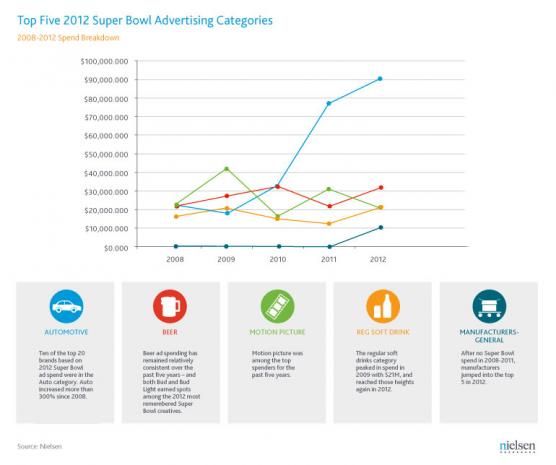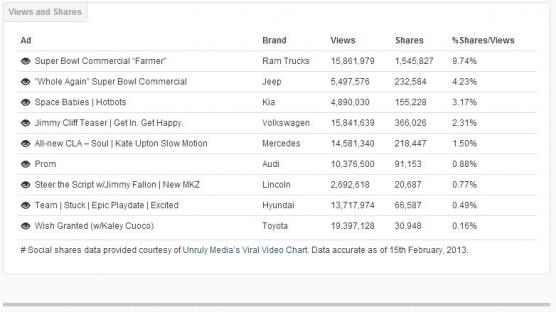Super Bowl 47 Car Ads – The Post-Game Reckoning (W/Videos)
Writes Steve Davies, of auto blog Skiddmark.
Most people if asked would say they weren’t interested in car ads, although perhaps what they really mean is they don’t ‘like’ car ads, because there’s a huge difference between the two.
I’d agree, most car ads amount to lame attempts by brands and agencies who don’t understand an automotive audience, trying to convince us their latest Turbo GT is like sex on wheels, when in fact watching it is like the time your Dad tried serving Sunday lunch – Gangnam Style.
The American Super Bowl season is different though. It’s like the Olympic Games for car ads, when some of the world’s top creatives are given free rein to think outside the box and sometimes.. they’re actually quite good to watch.
With a $4 million price tag for a 30-second TV advertising spot, it’s no wonder brands try especially hard to make it count. In 2012 we counted 16 different automotive ads (produced by 12 brands) who spent a staggering US$94.5 million on just the TV spots. These same ads (usually of extended duration) were also run online, accumulating a further 69 million views between them.
In 2013, the TV viewers were slightly down at 108.7 million versus 111 million in 2012 and this year only ‘one’ automotive ad featured in the Top 10 most viewed/shared.
A fortnight ago (that’s two weeks for our US friends) we looked at the main ads competing for your attention and tried to predict the winners and losers. Let’s see how close we got.
Winners And Losers In Super Bowl 2013
Prior to the game there were four brands which stood out from all the rest; Volkswagen (Get Happy), Mercedes-Benz (All-new CLA – Soul/Slow Motion), Audi (Prom) and Toyota (Wish Granted w/Kaley Cuoco). Before the game had even begun they’d clocked up 32.4 million views between them.
But what we hadn’t counted on was Ram Trucks (Chrysler/Dodge) and Jeep, both of whom played the sentimental hand with endearing stories of those who make sacrifices for all our benefit. Jeep earned some criticism for using the armed forces in their ”Whole Again” ad, while Ram Trucks missed a trick by its overt focus on white caucasian characters in “Farmer”, but even so it was Ram who pulled our heartstrings harder and earned the No.1 spot by a country mile.
What Did We Learn?
One of the more interesting observations you’ll note is how varied the yield is between the highest viewed video (Toyota’s Wish Granted w/Kaley Cuoco) and the lowest (Lincoln’s Steer the Script). In fact Toyota’s top viewed video was also the least shared (as a percentage of views) which raises the obvious question, “does it matter?”
I would argue it does.
Firstly, any campaign represents a balance between investment and return and whilst we’re not privy to the fee paid by Toyota to Kaley Cuoco, the Big Bang Theory actress can’t have been cheap. Cuoco has been an excellent ambassador for the brand, regularly tweeting mentions of the ad to her 1.1 million followers (and 0.5 million Facebook fans) and earning Toyota the advertising-value-equivalent of millions of dollars.
Advertising execs talk about ‘recall’ (memory of a brand and their product after seeing an ad), but recall is a diminishing asset that requires continual topping up to be of any real value – good for ad agencies, but less so for brands. Also recall is affected by ‘noise’ – which is a real problem online where anyone can (and does) produce new content every day.
Toyota will be hoping that the 19 million people who watched their ad will retain a positive memory of their brand (and the RAV4) which might sway their decision if they choose to buy a family SUV in the near future.
But evidence tells us that unless a viewer acts on that sentiment within the next few weeks, the likelihood of them doing so later is greatly diminished. That’s why we place such emphasis on sharing, it’s not just another way of increasing the view count, but it actually means a real person watched and then chose to encourage others to do the same.
Ad viewability is a big issue these days, namely how many of an ad’s recorded views were actually seen. With most people these days using more than one device at the same time (smartphones, TVs, tablets), actually seeing the ad being played in front of them is far from inevitable.
The point of advertising is to make people think or act differently and the only way to be sure of having some impact, is if they do something after watching an ad. Buying something would be nice, but the second best outcome is to share it. The other benefit of sharing is that it mimics the relationship between customer and supplier, and clearly the narrative of a relationship is far more valuable than a passing memory.
Advertisers get all caught up in attribution modelling (more accurately counting real views), but that’s a little bit like sticking your thumb in a sinking boat – make the ads worth engaging with in the first place and the problem goes away.
With Toyota at the bottom of our Super Bowl Car Ads, our attention turns to Ram Trucks, an unlikely winner especially since they waited until the game itself before releasing their ad. Current thinking suggests the best strategy is to release your ad a week or more early, grab the headlines with a teaser and then sustain the attention with that official big game ad. Ram Trucks did none of this, instead they simply focused on content which connected with their audience.
It took less than a week for the video to reach the 10 million view milestone, at which point the brand followed through on its pledge to donate $1 million to the National Future Farmers of America (FFA) Organization. Not only did they achieve twice the yield of any other brand, they also transferred the sentiment offline by supporting hunger relief efforts in local communities across America. That’s called a marketing touch-down.
You might be wondering how these videos compare with well-known YouTube hits, so to provide some perspective here’s a few to compare them with. Remember yield bears very little correlation with budget – the more a brand spends, the more likely they are to advertise, which in turn lowers the yield (word of mouth sharing only grows to fill a vacuum).
A video is shared because it creates an emotional response with its audience, either due to a spectacle, the poignancy of the message it conveys, or because it’s funny.
Sharing also depends on the environment. What you see with a lot of automotive content is how it gets containedwithin a forum, viewed by people who have no need to share it when they’re already talking within the groups they’ve chosen to identify with. This limits its reach and dilutes the resulting response, since the group knows the cars involved and will have already decided if they can (or will) purchase one. The value of such a PR investment comes from content being shared in groups whose decisions have yet to be formed, but automotive forums function in precisely the opposite way.
This raises the obvious question, “would brands be better off producing their own automotive videos, rather than relying on the media?” The results speak for themselves – professional brand content wins every time – but it would take a wholesale change in the way brands communicate with their customers and that’s a far bigger problem to fix than ad viewability.
The Parodies
Every good Super Bowl ad spawns a parody, and here is one of the best from 2013. The parody of Ram Truck’s ‘And God Made a Farmer’, picks up on the unfortunate racial stereotyping of the original ad.
Enjoy!
GOD MADE A NEGRO: GOD MADE A FARMER RAM TRUCKS SUPER BOWL COMMERCIAL
“OF
Original article appeared on Skiddmark.



